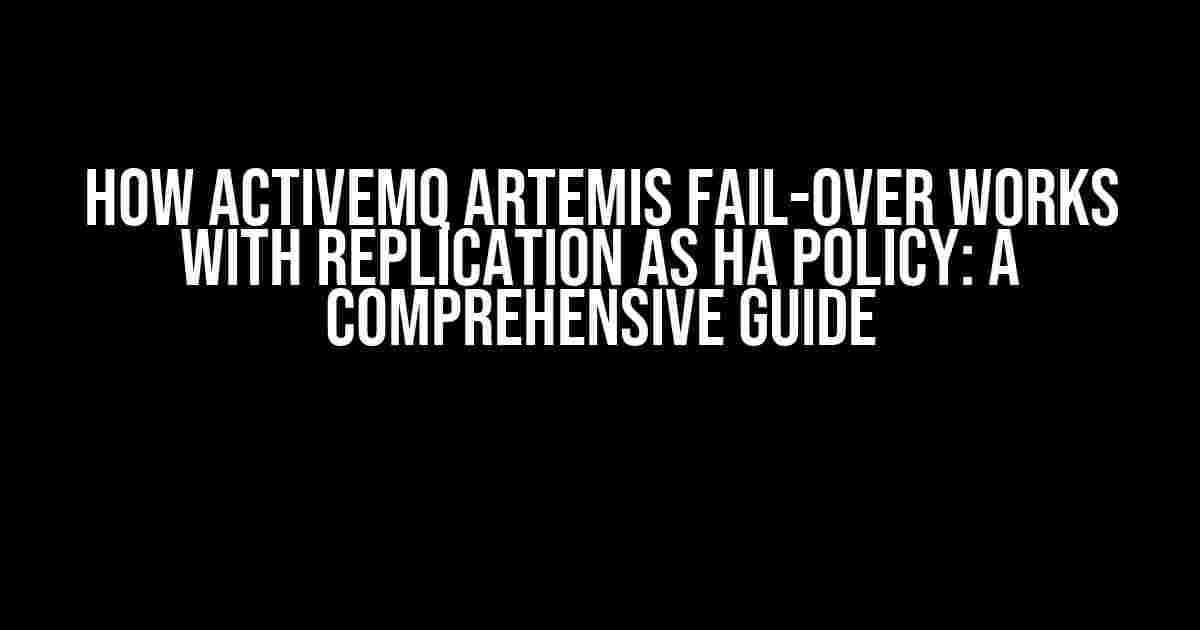When it comes to building highly available (HA) messaging systems, ActiveMQ Artemis stands out as a top contender. With its robust fail-over mechanism and replication as an HA policy, you can ensure that your messaging system remains operational even in the face of node failures. But have you ever wondered how this magic happens? In this article, we’ll delve into the inner workings of ActiveMQ Artemis fail-over with replication as an HA policy, providing you with a comprehensive guide to get you started.
What is Replication in ActiveMQ Artemis?
Replication is a fundamental concept in ActiveMQ Artemis that enables high availability by creating duplicate copies of data on multiple nodes. This means that if one node fails, the other nodes can take over, ensuring that the messaging system remains operational. In ActiveMQ Artemis, replication is achieved through a master-slave architecture, where one node acts as the master and one or more nodes act as slaves.
How Replication Works in ActiveMQ Artemis
The replication process in ActiveMQ Artemis involves the following steps:
- The master node receives a message and writes it to its local journal.
- The master node sends the message to the slave nodes, which write it to their local journals.
- The slave nodes acknowledge the receipt of the message to the master node.
- The master node updates its journal with the acknowledgment, ensuring that the message is safely replicated.
How Fail-over Works in ActiveMQ Artemis
Fail-over is the process of automatically switching to a backup node in the event of a failure. In ActiveMQ Artemis, fail-over is achieved through a combination of replication and live-backup nodes. Here’s how it works:
Imagine you have a cluster of three nodes: Node A (master), Node B (slave), and Node C (live-backup). Node A is the primary node, responsible for receiving and processing messages. Node B is the slave node, which replicates the messages from Node A. Node C is the live-backup node, which acts as a hot standby, ready to take over in case of a failure.
Fail-over Scenarios
There are two common fail-over scenarios in ActiveMQ Artemis:
Scenario 1: Node Failure
If Node A fails, Node B (slave) takes over as the new master node. Node C (live-backup) becomes the new slave node, and the messaging system continues to operate without interruption.
Scenario 2: Network Partition
If there’s a network partition between Node A and Node B, Node C (live-backup) takes over as the new master node, and Node B becomes the new slave node.
Configuring Replication as an HA Policy in ActiveMQ Artemis
To configure replication as an HA policy in ActiveMQ Artemis, you need to follow these steps:
Step 1: Configure the Broker
Edit the `broker.xml` file to configure the replication policy:
<broker xmlns="http://activemq.org/schema">
<ha-policy>
<replication>
<master>
<connector-ref>my-connector</connector-ref>
</master>
<slave>
<connector-ref>my-connector</connector-ref>
</slave>
</replication>
</ha-policy>
</broker>
Step 2: Configure the Connectors
Edit the `connectors.xml` file to configure the connectors:
<connectors>
<connector name="my-connector">
<factory>
<instance>
<property name="host" value="localhost"/>
<property name="port" value="61616"/>
</instance>
</factory>
</connector>
</connectors>
Step 3: Configure the Cluster
Edit the `cluster.xml` file to configure the cluster:
<cluster>
<cluster-name>my-cluster</cluster-name>
<nodes>
<node>
<name>node-a</name>
<host>localhost</host>
<port>61616</port>
</node>
<node>
<name>node-b</name>
<host>localhost</host>
<port>61617</port>
</node>
<node>
<name>node-c</name>
<host>localhost</host>
<port>61618</port>
</node>
</nodes>
</cluster>
Troubleshooting Fail-over Issues
In this section, we’ll cover some common fail-over issues and their solutions:
Issue 1: Node Failure Detection
Symptom: The fail-over process takes too long to detect node failures.
Solution: Adjust the `scan-period` property in the `ha-policy` element to reduce the time it takes to detect node failures.
<ha-policy>
<replication>
<master>
<connector-ref>my-connector</connector-ref>
</master>
<slave>
<connector-ref>my-connector</connector-ref>
</slave>
<scan-period>1000</scan-period>
</replication>
</ha-policy>
Issue 2: Data Loss
Symptom: Data is lost during fail-over.
Solution: Ensure that the `journal-max- files` property is set to a sufficient value to avoid data loss.
<broker>
<journal>
<journal-max-files>100</journal-max-files>
</journal>
</broker>
Conclusion
In this article, we’ve explored the inner workings of ActiveMQ Artemis fail-over with replication as an HA policy. By following the steps outlined in this guide, you can ensure that your messaging system remains highly available and resilient to node failures. Remember to troubleshoot common fail-over issues to ensure seamless operation. With ActiveMQ Artemis, you can build a robust messaging system that meets the demands of your business.
| Topic | Description |
|---|---|
| Replication | Creating duplicate copies of data on multiple nodes |
| Fail-over | Automatically switching to a backup node in the event of a failure |
| HA Policy | A configuration that ensures high availability of the messaging system |
| Master-Slave Architecture | A configuration where one node acts as the master and one or more nodes act as slaves |
| Live-Backup Node | A node that acts as a hot standby, ready to take over in case of a failure |
By mastering ActiveMQ Artemis fail-over with replication as an HA policy, you’ll be well on your way to building a highly available messaging system that meets the demands of your business.
- Learn more about ActiveMQ Artemis at https://activemq.apache.org/components/artemis/
- Explore the ActiveMQ Artemis documentation at https://activemq.apache.org/components/artemis/documentation/
- Get started with ActiveMQ Artemis tutorials at https://activemq.apache.org/components/artemis/tutorials/
Now that you’ve mastered ActiveMQ Artemis fail-over with replication as an HA policy, you’re ready to build a highly available messaging system that meets the demands of your business. Remember to
Frequently Asked Questions about ActiveMQ Artemis Fail-Over with Replication as HA Policy
Get the inside scoop on how ActiveMQ Artemis ensures high availability with replication!
What is the primary goal of replication in ActiveMQ Artemis fail-over?
The primary goal of replication in ActiveMQ Artemis fail-over is to ensure that messages are not lost in the event of a failure. By maintaining multiple copies of the message data, Artemis ensures that messages are highly available and can be recovered in case of a failure, thus providing a robust fail-over mechanism.
How does ActiveMQ Artemis achieve replication in a cluster?
ActiveMQ Artemis achieves replication in a cluster by maintaining a live copy of the message data on multiple nodes. This is done through a process called journal replication, where each node in the cluster maintains a copy of the message journal. The journal is replicated in real-time, ensuring that each node has an up-to-date copy of the message data.
What happens when a node fails in an ActiveMQ Artemis cluster with replication?
When a node fails in an ActiveMQ Artemis cluster with replication, the other nodes in the cluster detect the failure and automatically take over the responsibilities of the failed node. The remaining nodes continue to operate without interruption, ensuring that messages are still being processed and delivered. The failed node can then be restarted or replaced, and it will automatically re-synchronize with the other nodes in the cluster.
How does ActiveMQ Artemis handle network partitions in a replicated cluster?
ActiveMQ Artemis handles network partitions in a replicated cluster by using a quorum-based algorithm to determine which nodes are part of the active cluster. This ensures that even in the event of a network partition, the remaining nodes can still operate and make decisions about the cluster’s state. This prevents split-brain scenarios and ensures that the cluster remains consistent and highly available.
Can I customize the replication policy in ActiveMQ Artemis?
Yes, you can customize the replication policy in ActiveMQ Artemis to suit your specific use case. Artemis provides a range of configuration options, such as setting the replication factor, configuring the journal size, and defining custom replication policies. This allows you to tailor the replication policy to your specific requirements and ensure that your message broker is optimized for high availability and performance.



